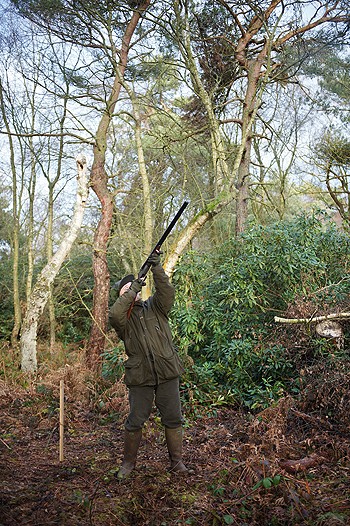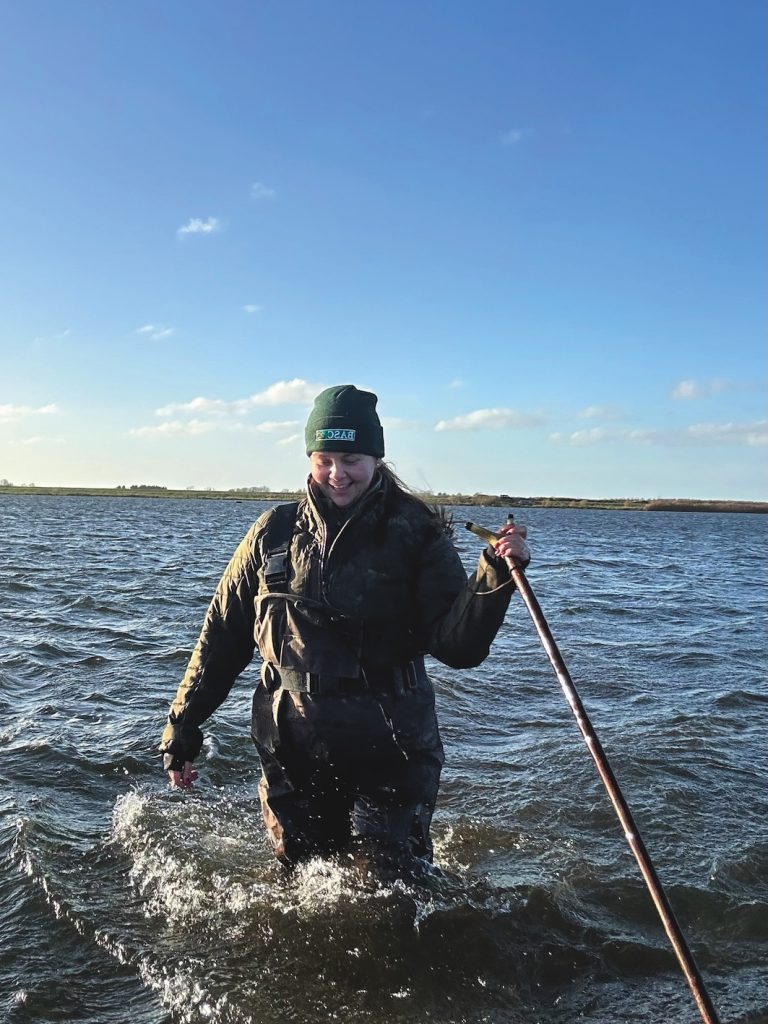Win CENS ProFlex DX5 earplugs worth £1,149 – enter here
Shoot Report – Rixton Firs Shoot
<strong>Hard work has transformed a Cheshire wasteland into a bronze Purdey Award-winning shoot. Ian Valentine enjoys a day with the syndicate</strong>

Part of the charm of the Purdey Awards is that they attract and commend conservation work from a great variety of shoots. This year?s bronze award was presented to a DIY shoot set in 54 acres of Cheshire woodland bog named Rixton Firs that could not differ more starkly from the Duke of Norfolk?s gold-award winning estate at Arundel, in West Sussex.
For the convivial souls who have made Rixton a regular fixture in their sporting calendar, the award was the icing on an already flavourful cake. That it exists at all is testament to their tireless work over the past two decades. Their drives and flightpond were hacked out of a peaty jungle of sphagnum moss covered in a forest of Scots pine and silver birch, and an undergrowth of bracken and dense rhododendrons.
At the heart of the transformation sits Alan Wilson, the part-time keeper who has spent much of his free time during the past 20 years in these woods, carving out his legacy on the landscape. He calls the shots during the shoot days, positioning the standing Guns and walking Guns in the five drives that criss-cross the enclosed area.
The original agenda in 1989 had been to roost shoot the odd pigeon, but that was soon superseded by grander plans, as the shoot?s potential became clear. ?Any pigeon shot on the woodland edge fell into the canopy and never reached the floor to be picked,? explained Alan, as the first shots rang out. ?A few of us tried to clear rides with machetes and chainsaws, but it was savage work with little gain. It was impenetrable in places. Even the dogs wouldn?t set foot in parts of it. But that also made it a challenge.?
Bloodied yet unbowed, these trailblazers decided to get tough. They purchased a second-hand Hymac tracked digger and fitted railway sleepers to the tracks. John Lennie, one of Rixton?s founding fathers with a career in engineering behind him, took up the story: ?We now had a super low-ground pressure machine to work with. At first, we pulled out trees to make rides, but that created holes in the bog that were so treacherous that even the dogs got stuck in them. The solution was to run over the silver birch and rhododendrons with the Hymac, digging a ditch on both sides of the new rides and then shifting the peat from the ditches on to the flattened trees. Only 12 months later, we had wide rides and good drainage. We also built our own tracked crop sprayer and eventually cleared six acres of bracken with Asulox.?
The work could be hazardous, with a risk of being sucked into the mire. Even today, it is wise to follow in the footsteps of those who know the terrain. To any onlooker uninitiated in the pleasures of shooting, this time and expense to create a habitat may have seemed extreme. Almost inevitably, this upheaval sparked resentment in one of society?s naysayers, who reported the shoot to the local borough council for removing protected Scots pine. Like naughty schoolchildren, Alan and John were summoned before the council to explain themselves.
?We had never touched the Scots pine, but it looked like we were going to be in deep trouble, until a man from the Mersey Valley Partnership announced that he had never seen such fantastic regeneration,? said Alan. ?Then the representative from the Forestry Commission said that if we had approached him first, they would have drawn up a plan and paid us to carry it out. In the end, we got the plan and the payments.?
A thriving syndicate
Rixton Firs soon became a syndicate with 10 Guns each paying £800 a year and all mucking in with the maintenance, though the lion?s share is still carried out by Alan. The annual fee covers the release of 800 ex-layers and the seven tonnes of wheat needed to nourish them. ?There are few shoots where everyone gets 12 months of enjoyment, as the summer work parties are every bit as fun as the winter shoot days,? he said.
The habitat improvements, predator control and feeding has turned a barren wasteland into a thriving ecosystem. Woodcock flit down the ride edges, tufted duck nest on the islands of the flightpond, and long-eared and tawny owls, merlins and sparrowhawks all hunt where hunting was once impossible. The local populations of grey partridge, lapwing and brown hare have also risen appreciably in the past two decades since the digging began.
Given the thick undergrowth, the dogs were the true champions of the shoot day. Beating with sticks was largely ineffective, so the plucky spaniels were sent out to startle pheasants from their snug tangles. Those with dogs walked and those without stood. Brian Farnworth stood a better chance than most of having game flushed in front of him, thanks to his tireless cocker bitch Belle, which punched well above her slight frame, and bravely launched herself into the briars.
A league of their own
Being so close to Warrington and Wigan, we were in the middle of rugby league country, known simply as rugby in these parts. ?We don?t play any of that Union rubbish,? quipped 11-year-old beater Charlie Shaw, who revels in joining his father and grandfather on the shoot. His father Ian was nursing a black eye and bruised ribs, which made him grimace as he swung on to a passing jay during the second drive. Only two days earlier, he had been trimming the hooves of a cow, which kicked out and sent a gate across the icy concrete into his upper torso.
?You can go looking for ways I could have avoided it, but sometimes these things simply happen,? he said.
Charlie looked like a dwarf next to the hulking figure of Andy Coley, prop for the Wigan Warriors, last year?s Championship-winning club. Andy can shoot, too, and demonstrated his ability against several high pigeon that circled the canopy, always keeping the Guns interested.
Tommy Martyn is another syndicate member to have hit the heights in rugby league, albeit several decades earlier. The second row toured Australia for England during the 1970s and helped Leigh Centurions to win the championship in 1982. His son also played at the highest level. ?They have it pretty easy nowadays,? he said, after bringing down a fine hen bird over his right shoulder. ?When I played, you had to fight for the ball in the scrums. It could be rough, I can tell you.
Evening flight
As the light started to fade, the Guns trooped off to their respective hides for the evening duck flight. I sensed that this was the highlight of the day for many. The Hymac had been used to dig out a one-and-a-half-acre pond, which captures water from the ditches via a system of sluices to ensure the level stays the same. Alan releases a number of duck on to the pond, which are fed all year round with 10 tonnes of wheat. Alan prefers to feed by hand, as the draw to rats is greatly reduced, but there is also an ingenious system of automatic feeders made from old explosives canisters, alarm clocks and a car-engine fan that sprays the grain out across the brackish water.
Most of the duck, however, are wild, with many journeying from far-flung places in the UK and Europe to be there, according to their rings. Mallard, teal, the occasional pintail, shoveler, gadwall, Canadas and greylag all stop in. For all but 11 days of the year, this is a duck paradise, but that night they approached at their peril.
The Guns rotate on a hide roster that is drawn at the start of the season to ensure that every member of the party has their turn in the hot seats. With several hundred duck soon spiralling the pond as dusk rolled in, however, you have to be unlucky to be out of the action.
Alan still seemed nervous. ?There?s no wind,? he grumbled. ?We need to let them come in and settle. Patience is key ? if we allow the first few singles and pairs to land on the water, we?ll have more luck with the bigger packs that follow.?
A voluntary ban had been considered after the cold weather, but Alan was happy that his duck were well fed, though he was ready to stand his Guns down if it became necessary.
It was John Lennie?s turn to take upresidence in the central hide, positionedon an island in the middle of the pond.He resisted the temptation to have a pop at the first incomers, as the skies filled with wildfowl, but he could wait no more when a pair of mallard swooped in range of his steel shot. Both fell out the sky, but John earned only a growl from Alan?s hide, as the rest of the approaching duck were scared off towards Manchester. They were back soon enough and all of the hides added to the sporadic din of shooting. The flights average 50 head per evening and tonight there was a steady stream of teal that swept by in groups.
All too soon, the night moved in and the torchlights switched on, allowing the Guns to send their dogs out for fallen birds. With such an enclosed area, the collection of every bird is a priority for Rixton Firs and a source of great pride, so nobody leaves until the last duck is found.
That sense of pride is, perhaps, the resounding impression I?ll take from Rixton Firs. There was no shoot here before the countless hours of toil. This was a dead end on the map: a no-man?s land. Now it is a thriving destination for sportsmen who revel in the game and wildlife here. It has earned its award.
?We didn?t set out to win awards or receive recognition,? concluded Alan, ?but the commendation from Purdey was a welcome boost. Above all, it allowed us to refl ect on all that we have achieved here. For that, we are grateful.?
Related Articles
Get the latest news delivered direct to your door
Subscribe to Shooting Times & Country
Discover the ultimate companion for field sports enthusiasts with Shooting Times & Country Magazine, the UK’s leading weekly publication that has been at the forefront of shooting culture since 1882. Subscribers gain access to expert tips, comprehensive gear reviews, seasonal advice and a vibrant community of like-minded shooters.
Save on shop price when you subscribe with weekly issues featuring in-depth articles on gundog training, exclusive member offers and access to the digital back issue library. A Shooting Times & Country subscription is more than a magazine, don’t just read about the countryside; immerse yourself in its most authoritative and engaging publication.







